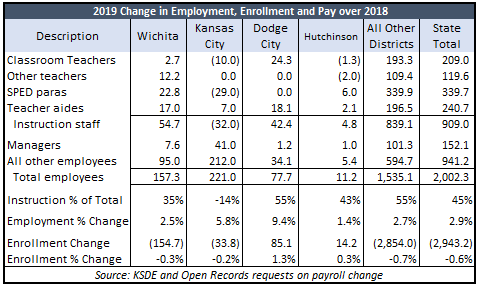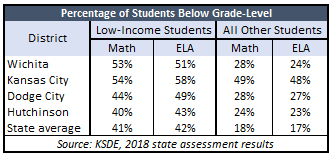After suing taxpayers for more than $1 billion on the premise that funding wasn’t adequate to educate students, the four plaintiff districts collectively allocated just 15% of their new hires last year to teachers, teacher aides, and special education paras.
USD 500 Kansas City was the worst offender, eliminating 32 classroom positions while added 253 non-classroom employees. USD 259 in Wichita added about 55 classroom positions, but that was only a third of total staff additions. Dodge City and Hutchinson also added classroom positions, but only Dodge City had more employees added to classrooms than elsewhere. The very districts that sued taxpayers for more money appear to be spending those dollars to “plug holes” in their organizational charts.
The very districts that sued taxpayers for more money appear to be spending those dollars to “plug holes” in their organizational charts.
-> Wichita added 4 directors and 10 workers to their maintenance staff. They added 6 clerical workers, 6 people in technology, 12 people in foodservice, and 4 people classified as ‘other’ while adding less than three classroom teachers.
-> Kansas City cut 10 classroom teachers and 29 special education paraprofessionals, but added 63 positions in food service, 11 in maintenance, 18 in transportation, 11 clerical staff, and 95 people classified as ‘other.’
-> Dodge City added 13 maintenance workers, 6 in transportation, 7 clerical staff, and 6 people classified as ‘other.’
Instruction is the most important function
The Kansas Department of Education Accounting Manual says Instruction accounts for direct interactions between teachers and students; this ‘bible’ of school spending says, “Although all other functions are important, this function acts as the most important part of the education program, the very foundation on which everything else is built. If this function fails to perform at the needed level, the whole educational program is doomed to failure regardless of how well the other functions perform.”
Unfortunately, local school boards and administrators don’t seem to pay much attention to that guidance. Each year, districts barely allocate half of total spending to Instruction. And that’s also reflected in district hiring patterns.
The House passed such a bill this year that would require districts to certify that they’ve allocated sufficient funds and personnel to Instruction so that students can get to grade-level but the Senate didn’t consider it.
What’s at stake
A few years ago, the state supreme court said upwards of 25% of students below grade-level on state assessments somehow ‘proves’ that schools are underfunded, but local school boards are not required to allocate funding and personnel to get students to grade level. It’s now closer to 30% of all students who are below grade-level.
 Over 70% of students in the plaintiff districts are considered low-income (based on eligibility for free/reduced lunch), and about half of them are below grade-level. Statewide, more than 40% are below grade-level. There are also large numbers of kids below grade-level who aren’t considered low-income but overall, the incidence of being below grade-level is less than half that of low-income kids.
Over 70% of students in the plaintiff districts are considered low-income (based on eligibility for free/reduced lunch), and about half of them are below grade-level. Statewide, more than 40% are below grade-level. There are also large numbers of kids below grade-level who aren’t considered low-income but overall, the incidence of being below grade-level is less than half that of low-income kids.
Given the lack of urgency paid by the districts to these students, it is incumbent on the Legislature to require some sort of oversight to assure the additional taxpayer dollars are being spent as intended.
Anything less is unacceptable to those students, their families, and Kansas taxpayers.




